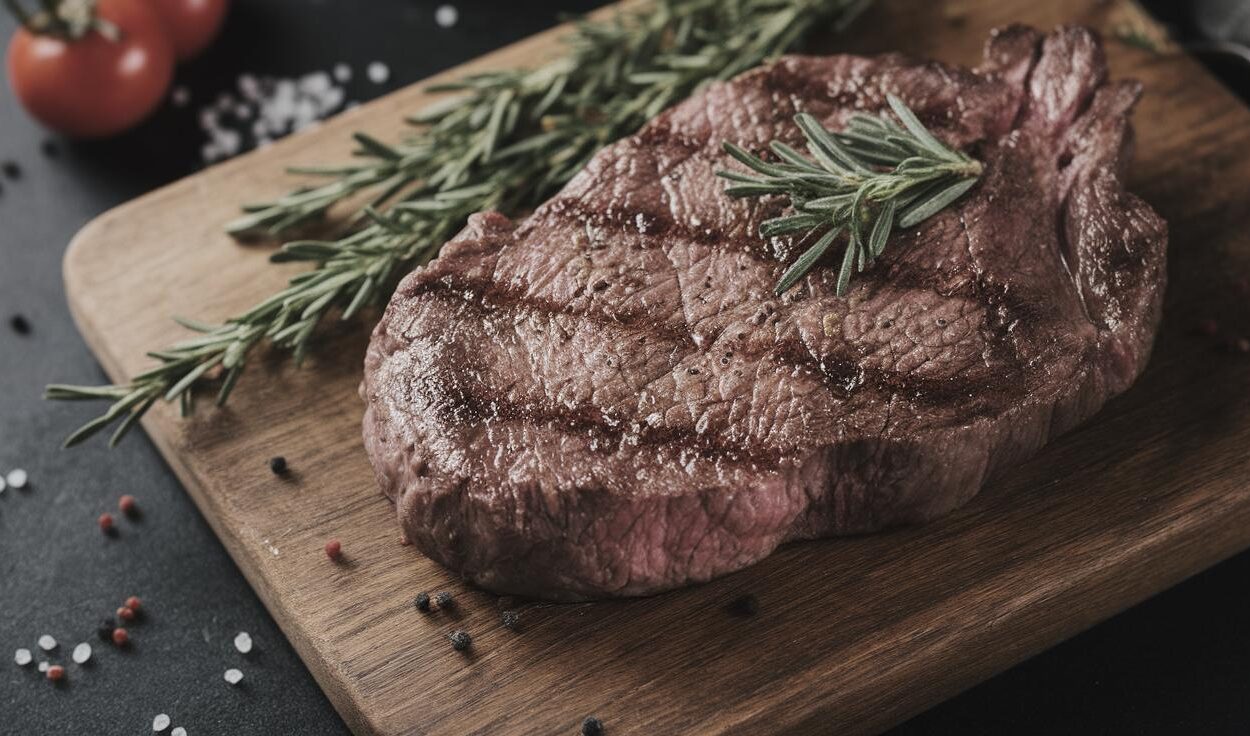Cooking the Perfect Steak: A Complete Guide
Ready to dive into the world of steak cooking? This comprehensive guide covers everything from steak preparation to creating mouth-watering pairings. We’ll share essential tips straight from the chef’s table, explore different steak varieties, and offer an instructional video for visual learners. Furthermore, you’ll get a detailed, step-by-step guide and a peek into the nutritional details to make informed choices. Plus, don’t miss the adorable adventures of Dozer, an enthusiastic Chef’s assistant. Read on to master the art of steak cooking!
Mastering Steak Preparation – Chef’s Technique!
Preparing steak is an art form that demands attention to detail and an appreciation for quality. A chef’s technique begins with selecting the right cut. Prime cuts like ribeye, filet mignon, and New York strip are favored for their marbling and tenderness. Each cut brings its unique blend of flavor and texture, ensuring a memorable culinary experience.
Next, let your steak reach room temperature before cooking. This step is crucial in ensuring even cooking throughout the meat. Cold steaks tossed into a hot pan can lead to a tough exterior and raw interior. Pat your steak dry with a paper towel to create a beautiful crust when seared.
Finally, seasoning is key. A generous sprinkle of salt and freshly ground black pepper should coat every inch of the steak. While some prefer to marinate, a well-seasoned steak can hold its own. Allow the steak to rest after seasoning so the flavors seep into the meat before hitting the heat.
Necessary Ingredients
When it comes to cooking steak, your ingredient list is refreshingly simple. Your primary focus is the steak itself, which should be the highest quality you can afford. Look for bright red meat with a generous amount of marbling for tenderness and flavor.
Essential seasonings include kosher salt and freshly ground black pepper. These two condiments are crucial in enhancing the steak’s flavor, providing a savory balance that complements the meat’s natural richness. You might also consider adding garlic or onion powder for an additional flavor dimension.
Optional ingredients can elevate your steak experience. Herbs like thyme, rosemary, or parsley add aromatic depth, while a pat of butter finishes the steak with a silky sheen. Feel free to experiment with add-ons until you find your perfect flavor combination.
Expert Tips for Cooking Steak!
Timing is everything in the world of steak cooking. For a perfect medium-rare finish, a steak should stay on the heat for about 3-4 minutes per side, depending on thickness. Use a meat thermometer for precision, aiming for an internal temperature of 130°F (54°C).
Another key tip is to use a hot pan. Whether you’re employing a grill, skillet, or broiler, the surface needs to be smoking hot. A well-seared steak locks in juices and forms a delectable crust, amplifying the overall experience.
Finally, never underestimate the power of resting your meat. Once cooked, let your steak sit uncovered for at least five minutes. This resting period allows the juices to redistribute, ensuring each bite is juicy and flavorful.
Perfect Pairings for Steak
Steak is a versatile main course that pairs beautifully with various sides. Classic accompaniments include mashed potatoes, roasted vegetables, or a simple green salad, each providing a complementary balance to the steak’s richness.
Adding a sauce or dip can elevate your steak dinner. Béarnaise, chimichurri, or peppercorn sauce offer complementary flavors that enhance the meat. A dash of blue cheese butter or garlic aioli can further impress your taste buds.
Wine enthusiasts will appreciate a good pairing. Rich reds, like Cabernet Sauvignon or Malbec, with their robust profiles, stand up to the heartiness of steak, creating a symphony of flavors on the palate.
Additional Steak Varieties
While traditional cuts like ribeye and filet mignon are popular, exploring lesser-known steak varieties can enrich your culinary repertoire. Think of hanger steak, often referred to as “the butcher’s secret,” for its incredible flavor.
Flank steak, known for its robust taste and lean texture, is a perfect candidate for marinades, absorbing flavors like a sponge. This cut is ideal for dishes like fajitas, where a bold, spicy profile is key.
Finally, consider trying skirt steak. Praised for its intense beefy flavor, it’s especially well-suited for grilling. When cooked quickly on high heat and sliced against the grain, it delivers a tender, juicy bite every time.
Instructional Video
For visual learners, nothing beats a step-by-step video on how to cook the perfect steak. Watching an expert chef in action can provide invaluable insights into techniques and timings. Pay attention to details like the pan’s heat, the time spent on each side, and how the steak is rested.
Many instructional videos offer tips on plating and presentation, helping you showcase your steak like a pro. Follow along, pausing the video as needed, to perfect each step at your own pace.
Consult cooking channels or online platforms like YouTube for a plethora of steak-cooking demonstrations. Choose a video that aligns with your preferred cooking method—be it grilling or pan-searing—to maximize its learning potential.
Chef-Style Steak Cooking Guide!
Ingredient List
- 2 ribeye steaks (about 1-inch thick)
- Kosher salt
- Freshly ground black pepper
- 2 tablespoons olive oil
- 2 tablespoons unsalted butter
- 3-4 garlic cloves, smashed
- Fresh herbs: rosemary or thyme
Step-by-Step Guide
1. Remove steaks from the refrigerator, season with salt, and let sit to reach room temperature (about 30 minutes).
2. Preheat your skillet over high heat until almost smoking.
3. Pat steaks dry and season with pepper just before cooking.
4. Add olive oil to the skillet and carefully place steaks in the hot pan.
5. Sear for 3-4 minutes without moving the steak, then flip and sear the other side equally.
6. Reduce heat to medium, add butter, garlic, and herbs, basting the steaks with the melted mixture.
7. Use a thermometer to check internal temperature for doneness (130°F for medium-rare).
8. Let steaks rest for 5 minutes before slicing against the grain.
Recipe Annotations:
Feel free to adapt the seasonings to suit your taste. Adding garlic powder or smoked paprika can infuse additional layers of flavor. Experiment by swapping rosemary for thyme or introducing other fresh herbs to tailor the taste to your liking.
For those without a meat thermometer, use the finger test to gauge doneness—gently press the center of the steak; it should feel like the fleshy area of your relaxed thumb for medium-rare.
Keep the kitchen well-ventilated when searing as it may generate smoke. If you’re using a cast-iron skillet, its heat retention aids in achieving an even sear, enhancing the overall texture.
Nutritional Details:
Steak is an excellent source of protein, essential for muscle repair and growth. A 3.5-ounce portion of ribeye typically contains 250-300 calories, 20-25 grams of protein, and 20 grams of fat, depending on the seasoning and preparation methods.
Rich in vitamins such as B12, which supports brain function, and minerals like zinc and iron for immune health, steak can be a nourishing addition to your diet when consumed in moderation.
For those monitoring fat intake, choosing leaner cuts or trimming visible fat can reduce the caloric content. Pairing steak with vegetables adds fiber, enhancing satiety and nutritional balance.
Dozer’s Adventures
In the vibrant world of steak cooking, our furry friend Dozer, an enthusiastic kitchen companion, adds a playful twist. Always eager, he’s on the lookout for any morsels or tips, proving his taste buds are as discerning as any gourmet chef’s.
Dozer’s adventures don’t end at the dining table. You’ll often find him “helping” with the cleanup, ensuring not a single drop of steak juice goes to waste. His lively presence adds rhythm and joy to every kitchen endeavor.
Whether he’s waiting patiently by the grill or accompanying a seasoned chef on a grocery run, Dozer symbolizes the bonds we create through food, transforming meals into shared experiences filled with love and laughter.
FAQ
What is the perfect way to cook a steak?
The perfect way to cook a steak is to season it with salt and let it rest to room temperature, then sear it in a hot pan or grill for a few minutes on each side until it reaches your desired internal temperature. Use a meat thermometer to ensure accuracy, aiming for 130°F for medium-rare. Finally, let it rest for a few minutes before serving to allow the juices to redistribute.
How to cook steak in a frying pan?
Season the steak with salt and pepper, then heat a bit of oil in a frying pan over medium-high heat. Cook the steak for about 3-4 minutes on each side for medium-rare, adjusting the time based on your desired doneness. Let the steak rest for a few minutes before serving.
What is the 3-3-3 rule for steaks?
The 3-3-3 rule for cooking steaks is a method for grilling a steak to achieve even cooking and a good sear. It involves cooking the steak for 3 minutes on one side, then flipping it and cooking for another 3 minutes on the other side, and finally resting for 3 minutes before serving. This method is often used for achieving medium-rare doneness.
How does Gordon Ramsay cook steak?
Gordon Ramsay cooks steak by seasoning it with salt and pepper, then searing it in a hot pan with olive oil to develop a crust. He typically adds butter, garlic, and herbs like rosemary or thyme, basting the steak for flavor. The steak is then rested for a few minutes before serving to ensure juiciness.
Lessons Learned
| Section | Key Points |
|---|---|
| Mastering Steak Preparation | Select quality cuts, bring to room temperature, and season well. |
| Necessary Ingredients | Focus on high-quality steak and essential seasonings; experiment with herbs. |
| Expert Tips | Use hot pans, precise timing, and rest your steak. |
| Perfect Pairings | Classic sides, sauces, and wine enhance the steak experience. |
| Additional Steak Varieties | Consider cuts like hanger, flank, and skirt for varied flavors. |
| Instructional Video | Visual learning through video aids perfect technique. |
| Chef-Style Guide | Detailed ingredients and method for foolproof steak cooking. |
| Dozer’s Adventures | A charming reminder of the joy and connection found in cooking. |




